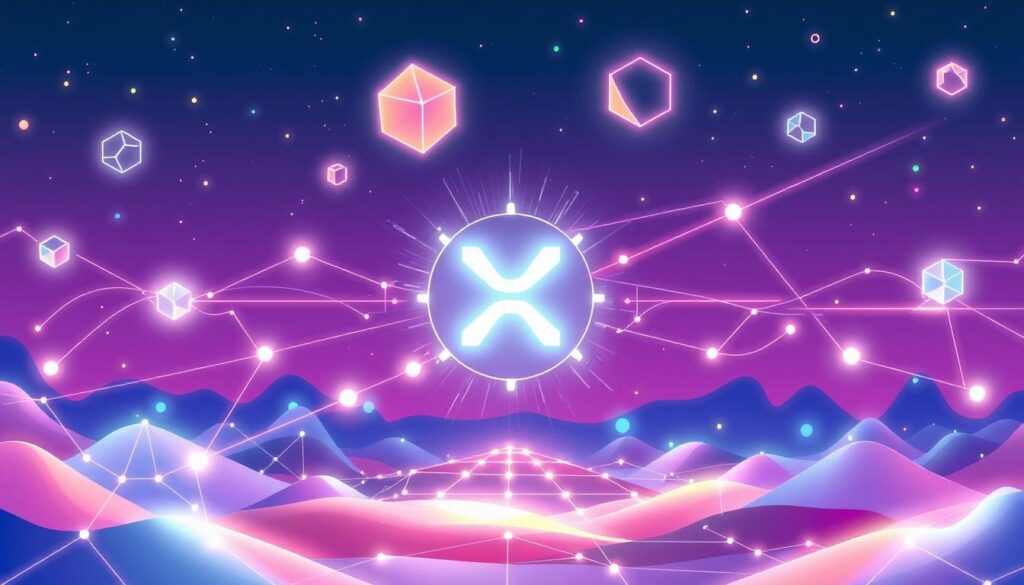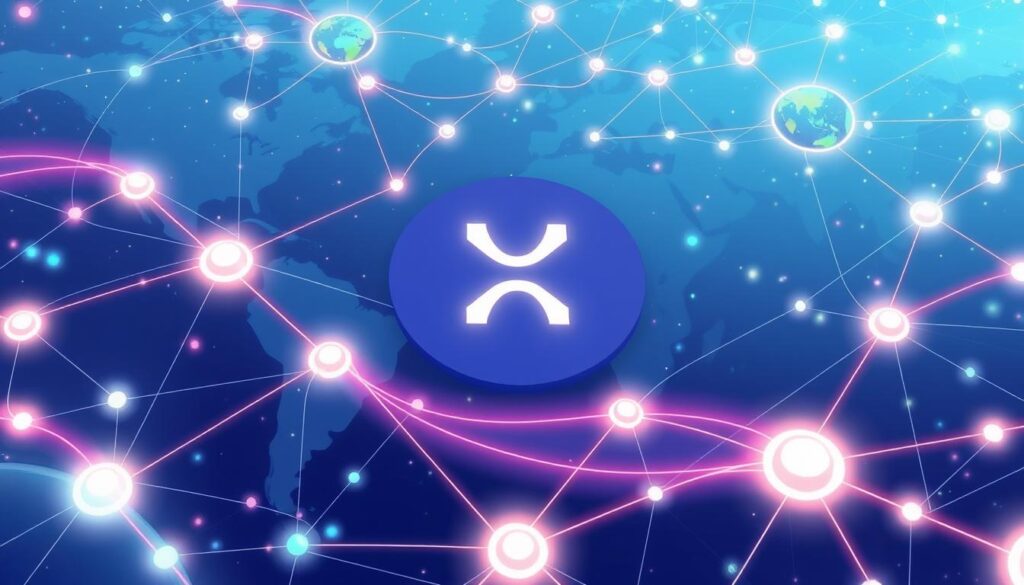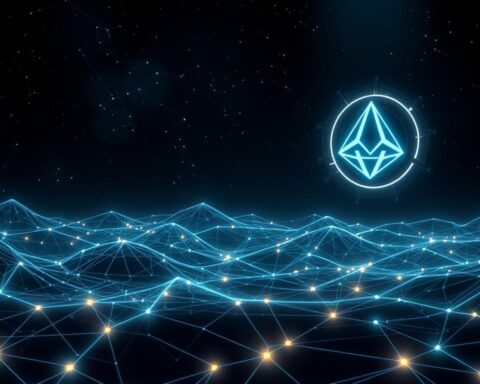The world of cryptocurrency is changing fast, with Ripple (XRP) leading the way in cross-border payments. Ripple just launched its own stablecoin, Ripple USD (RLUSD), tied 1:1 to the US dollar1. This move is timely, given the global cross-border payments volume hit $130 trillion in 2022. Daily transactions topped $5 trillion1.
The SWIFT network handles 42 million messages daily across 11,000 financial institutions in over 200 countries. This shows the huge scale and opportunity in this market.
Ripple is now focusing on stablecoins while it fights legal battles with the SEC. The SEC says Ripple sold $1.38 billion worth of XRP tokens without registering them as securities. This has cost Ripple over $100 million in legal fees2. Despite this, Ripple keeps innovating, aiming to make cross-border transactions faster and more efficient.
Ripple’s stablecoin could be a big win for secure, fast, and clear cross-border payments. Its tech is fast and uses little energy, unlike old banking systems1.
Key Takeaways
- Ripple (XRP) has emerged as a prominent player in the cross-border payment systems, with the launch of its stablecoin, Ripple USD (RLUSD).
- The global cross-border payments volume reached $130 trillion in 2022, with daily transaction values exceeding $5 trillion.
- Ripple’s transition to a stablecoin provider amid legal battles with the SEC holds the potential to reignite its connections with the cross-border payments industry.
- Ripple’s technology offers lightning-fast transaction speeds and minimal energy usage, setting it apart from traditional banking systems.
- The regulatory landscape remains a key challenge, but Ripple’s resilience and commitment to innovation continue to drive its evolution in the financial sector.
Understanding Ripple’s Evolution in Digital Finance
Ripple started in 2012 and has changed how we send money across borders. It uses blockchain tech. RippleNet lets banks send money directly, using XRP as a middleman3.
This method makes transactions fast, taking only 3-5 seconds. Ripple can handle up to 50,000 transactions per second. This is much faster than old banking systems3.
The Genesis of Ripple Protocol
Ripple began with the Ripple protocol. It was made to let people send money directly, without a middleman3. The system checks transactions on a shared ledger, keeping everything safe and sound3.
Now, RippleNet has over 300 banks and handles billions of dollars in payments every year3.
Key Milestones in Ripple’s Development
Ripple has hit many important milestones4. It has raised $293.8 million in 14 rounds of funding. Its value has soared to over $11 billion4.
But, Ripple has also faced big challenges. It was fined $125 million by the SEC in 2024 for selling unregistered securities4.
RippleNet’s Core Infrastructure
The XRP Ledger is at the center of Ripple’s world3. It’s a public blockchain that supports XRP. XRP is special because it’s pre-mined, with 100 billion tokens created3.
Ripple Labs holds about 48 billion XRP in escrow3. The XRP Ledger is also very energy-efficient. It can handle 1,500 transactions per second, making international money transfers cheaper3.
Ripple is growing and looking into new uses for XRP Ledger. It’s working on Central Bank Digital Currencies and with new tech like NFTs and DeFi3. Ripple is changing the game in digital finance3.
Ripple has grown a lot in digital finance. It uses blockchain to make sending money across borders easier. It offers a fast, cheap, and secure way to send money, unlike traditional banks3.
“Ripple’s protocol has the power to change global payments. It makes them faster, cheaper, and more accessible.” – Industry Analyst
The Current State of Cross-Border Payment Systems
The old ways of making payments across borders have big problems. These include slow speeds, hidden fees, and unclear costs5. But, new tech and fresh players are changing the game6.
SWIFT has been a big name in global money moves. But, it knows it needs to get better. So, it started SWIFT gpi to make things faster and clearer6. Fintechs are now using SWIFT’s network to make payments smoother.
Blockchain tech, like Ripple, is a big hope for better payments. It promises quick, clear, and cheaper ways to send money across borders5. Ripple uses XRP to help move money between different currencies fast5.
| Metric | Value |
|---|---|
| Cross-border payments market size (projected by 2030) | $290 trillion6 |
| Blockchain revenue share for payments applications (2022) | 44%6 |
| Global crypto payment gateway market (projected by 2031) | $5.4 billion6 |
| B2B cross-border payments on blockchains (estimated by 2024) | 11% of total B2B international payments6 |
The future of global money moves looks bright. New tech like blockchain and stablecoins will be key6.
Ripple’s Technology Stack and Architecture
Ripple’s cross-border payment solutions are built on a strong technology stack and design. The XRP Ledger, a public blockchain, is at the core of RippleNet7. This tech makes transactions secure and transparent, cutting out middlemen and speeding up payments8.
XRP Ledger Fundamentals
The XRP Ledger is Ripple’s native cryptocurrency, with 100 billion tokens available7. Each XRP can be split into a million “drops” for precise transactions7. Users need at least 20 XRP to join the Ripple network7.
Consensus Protocol Mechanism
Ripple uses the Ripple Protocol Consensus Algorithm (RPCA) to validate transactions7. This algorithm relies on validators to check and agree on transactions7. It’s more energy-efficient than mining, making transactions cheaper and greener8.
Smart Contract Integration
Ripple also supports smart contracts for more complex transactions7. These contracts can automate financial processes, like escrow and conditional payments7. This makes Ripple’s ecosystem more versatile and functional7.
Ripple’s use of distributed ledger tech, consensus mechanism, and smart contracts makes it a key player in digital finance and global payments78.
“Ripple’s technology stack and architecture are designed to revolutionize cross-border payments, with unmatched speed, efficiency, and security.” – Blockchain Technology Expert
Cryptocurrency, Coins, Ripple (XRP) Security, Blockchain Technology,Ripple (XRP)
Ripple is a blockchain-based network that uses XRP cryptocurrency for cross-border payments. The XRP Ledger (XRPL) is a secure platform for digital asset transactions. It uses blockchain technology for transparency and to prevent changes10.
The XRPL has been reliable for over a decade, handling over 63 million ledgers without a single error10. It settles transactions in seconds, showing its speed. Each transaction costs just fractions of a penny10. The XRPL also has a built-in decentralized exchange, making trading easier for users10.
The XRPL makes cross-currency payments easy, allowing smooth transactions across borders10. The XRPL community, made up of companies, developers, validators, and users, works together to improve the ledger10.
Ripple has faced challenges from the U.S. Securities and Exchange Commission (SEC). The SEC claims XRP is an unregistered security. Ripple argues XRP is a digital asset, not a security, and is working with regulators to comply.11
The XRP Ledger’s security and blockchain technology are key to its success. The XRPL settles transactions every 3 to 5 seconds11. XRP is also more energy-efficient than many other cryptocurrencies11.
Ripple Labs aims to achieve net-zero carbon emissions by 2030. This shows its commitment to sustainability and responsible development11.
The Ripple network and XRP cryptocurrency are leaders in the DeFi revolution. They offer new solutions for cross-border payments and digital asset management12.

RippleNet’s Global Payment Network
Ripple’s cross-border payment network, RippleNet, has grown to serve over 300 financial institutions worldwide13. It includes big banks, payment providers, and fintech companies. They use Ripple’s tech to make global payments faster, clearer, and cheaper13.
Partnership Ecosystem
Ripple teams up with places needing quicker and cheaper cross-border payments13. It works with big names like Santander and Kotak Mahindra Bank. Together, they offer new payment solutions with RippleNet13.
These partnerships help with things like e-Invoicing and international supply chain payments13. They also support real-time cash pooling, international bill pay, and real-time remittances13.
Financial Institution Integration
RippleNet’s tech stack includes xCurrent, xRapid, and xVia13. These tools help banks make cross-border payments smoother13. xCurrent helps banks cut costs and offer new payment services13.
xRapid uses XRP for quick liquidity, reducing costs for banks13. xVia is a simple API for sending payments worldwide with clear updates13.
Ripple’s solutions and global network make RippleNet a key player in cross-border payments13. As the need for fast, affordable, and clear international payments grows, Ripple’s tech is ready to change how we move money13.
SWIFT vs. Ripple: Comparative Analysis
In the world of international banking and financial messaging, two big players stand out: SWIFT and Ripple. They both help with cross-border payments but in different ways14.
SWIFT is the go-to for global financial transactions. It handles 44.8 million messages daily through its vast network of over 11,000 members14. Ripple, on the other hand, uses blockchain for payments. It has processed $30 billion and done 20 million transactions14.
SWIFT transactions can take one to five business days. This depends on how many banks are involved15. Ripple, though, settles transactions almost instantly, usually in seconds15.
SWIFT uses a network of banks, while Ripple uses its XRP cryptocurrency for direct transfers15. Ripple’s method cuts fees by skipping middlemen and makes transactions clearer and quicker15.
| Metric | SWIFT | Ripple |
|---|---|---|
| Daily Message Volume | 44.8 million14 | N/A |
| Member Institutions | Over 11,00014 | N/A |
| Transaction Volume | $300 billion daily14 | $30 billion total14 |
| Transaction Speed | 1-5 business days15 | Seconds15 |
| Transaction Fees | Varies | Minimum 0.00001 XRP per transaction14 |
Ripple beats SWIFT in speed and fees, but SWIFT’s wide network is a big plus. SWIFT connects over 200 countries and more than 11,000 banks15.
The battle between SWIFT and Ripple shows a move towards quicker and cheaper cross-border payments. As the financial world changes, both will keep improving to meet new needs1415.
Regulatory Landscape and Compliance
The world of cryptocurrency faces a complex and changing set of rules. Financial regulators everywhere are trying to find the right balance. They want to encourage new ideas while keeping the financial system safe16.
The European Union has made big moves. In September 2024, they introduced rules to stop bad uses of virtual assets16. In the U.S., the Securities and Exchange Commission (SEC) has been very active. They have sued companies like Ripple, Coinbase, and Binance16.
SEC Litigation Impact
Ripple, the company behind XRP, is in a big legal fight with the SEC17. The SEC says Ripple sold over $1.3 billion in XRP without the right permits17. But, a court in 2023 said Ripple was okay when selling XRP to the public, not just to big investors1618.
This decision has made XRP more popular. It could make the whole crypto world more stable and trusted17.
Global Regulatory Framework
Cryptocurrency rules differ a lot around the world16. Canada was the first to approve a Bitcoin ETF, while the U.K. banned crypto derivatives16. Japan taxes crypto gains as regular income, and Australia taxes them as capital gains16.
Singapore doesn’t tax long-term crypto gains, and South Korea has new laws for crypto users16. This mix of rules is hard for companies like Ripple to follow1618.
The rules for crypto are always changing. Governments and financial groups are working hard to find the right balance1618. Ripple and other crypto companies must keep up with these changes and work with regulators161718.
XRP’s Role in Liquidity Management
XRP is a key player in the Ripple network’s liquidity management. It acts as a bridge currency, making cross-border transactions fast and easy on RippleNet19. This means banks don’t have to keep lots of money in different currencies. Instead, they can use that money for other important things.
Every transaction on the XRP Ledger costs at least 0.00001 XRP. This small fee helps keep the network safe from spam19. By using XRP, banks can quickly switch currencies without needing extra accounts. This saves them a lot of money and makes things more efficient19.
| Metric | XRP | Bitcoin | Ethereum |
|---|---|---|---|
| Transaction Time | 3-5 seconds20 | 10 minutes21 | 2 minutes21 |
| Transaction Fees | Fraction of a cent20 | $20 – $5021 | Under $121 |
| Transactions per Second | 3,40020 | 721 | 3021 |
The Ripple ecosystem has three main products: xRapid, xCurrent, and xVia. They all use XRP in different ways19. xRapid uses XRP to make fast and cheap cross-currency transfers19. xCurrent helps banks make quick and cheap payments without always using XRP. It uses IOUs for asset exchange19. xVia makes it easy for banks to work together by providing a standard API19.
The Ripple network is secure and reliable, thanks to its unique consensus algorithm and careful validator selection19. This makes it a great choice for banks looking to improve their digital assets and cryptocurrency liquidity provision strategies19. XRP is one of the top three cryptocurrencies and is recognized by big institutions like the National Bank of Abu Dhabi for its ability to handle big transactions19.
“Ripple’s promise lies in secure interbank exchanges via a consensus mechanism, receiving recognition from powerful institutions like the National Bank of Abu Dhabi for high-value transactions.”
Ripple’s Market Position and Competition
Ripple is a big name in the world of cross-border payments. It handles billions of dollars in transactions every year. This makes it a strong rival to old systems like SWIFT and other blockchain options22.
Market Share Analysis
Ripple is growing fast, but SWIFT is way ahead in cross-border payments22. Yet, Ripple’s new way of handling money is catching on. It’s faster and cheaper than traditional banks.
Competitive Advantages
Ripple stands out because it’s quick, cheap, and helps manage money better23. It can do up to 1,500 transactions per second, beating old systems hands down23. Plus, its fees are almost nothing, making it a smart choice for sending money across borders23.
Ripple has teamed up with big names like Santander, American Express, and Standard Chartered23. These partnerships show Ripple’s tech works well with the biggest players. It’s becoming a key part of the digital finance world.
“Ripple offers a reliable and efficient solution for businesses to manage international payments, reducing operational costs and improving cash flow.”
Innovation in Payment Processing Speed
Ripple’s blockchain technology is changing how we do international money transfers. It’s much faster than the old SWIFT system, which can take up to 5 days. Ripple’s XRP ledger can settle transactions in seconds, saving money on fees24.
Ripple’s XRP acts as a bridge for different currencies, making transfers easier. This solves a big problem in cross-border payments, where delays and high costs were common. Ripple’s tech makes transactions fast and cheap, no matter where you are in the world25.
Even though SWIFT gpi has improved, Ripple is faster and more efficient24. SWIFT has a 5% error rate because of many middlemen, which raises costs. XRP settles transactions in real-time, cutting out the need for extra banks and accounts24.
Ripple has teamed up with big names like Santander and American Express. These partnerships show that Ripple’s tech is valued in the industry25. By using Ripple, these companies can offer faster, cheaper payment services, making Ripple a key player in digital finance.
| Metric | Bitcoin | XRP |
|---|---|---|
| Transaction Confirmation Time | ~10 minutes | 3-5 seconds |
| Transaction Fees | Variable, can increase during peak times | Consistently low regardless of network demand |
| Consensus Mechanism | Proof-of-Work (energy-intensive) | Ripple Protocol Consensus Algorithm (energy-efficient) |
| Environmental Impact | Significant annualized environmental footprint due to mining | Minimal environmental impact |
Ripple is leading the way in fast, affordable cross-border payments. Its technology is a big step forward for the financial world242526.
“Ripple’s blockchain-based solutions have the power to change cross-border payments. They offer speed, efficiency, and savings.”
Ripple’s success depends on new rules, partnerships, tech improvements, and wider acceptance25. As Ripple keeps pushing the limits of payment speed, it’s shaping the future of money transfers242526.
Cost Efficiency and Transaction Fees
Cost efficiency is key in cross-border payments. Ripple’s tech could be cheaper than old systems like SWIFT. It cuts out middlemen, lowering costs27.
SWIFT charges for network use, currency exchange, and bank fees. But Ripple’s XRP Ledger only costs 0.00001 XRP for a transaction28.
Fee Structure Analysis
The XRP Ledger’s fees are set to be low and flexible. The base cost is 10 “drops” (0.00001 XRP). But, this can go up when the network is busy to stop spam28.
Transaction costs vary. Reset transactions are free, while multi-signed ones cost a bit more28. The cost is only taken from the sender when the transaction is confirmed28.
Cost Comparison with Traditional Systems
Traditional systems like SWIFT are pricier. Bitcoin fees have hit $128, while XRP charges nothing29. XRP is faster and cheaper than Bitcoin29.
The XRP Ledger’s unique way of confirming transactions makes it cheaper and quicker27.
| Metric | XRP | Bitcoin |
|---|---|---|
| Total Supply | 100 billion27 | 21 million29 |
| Transaction Confirmation Time | 3-5 seconds29 | 10 minutes to several hours29 |
| Typical Transaction Fee | 0.00001 XRP (10 drops)28 | $1.20 in November 202429 |
Ripple’s low fees and fast transactions make it a strong choice for cross-border payments272928.

Security Infrastructure and Risk Management
Digital finance and cross-border payments need strong security to fight off threats. Ripple’s blockchain technology is secure because it’s decentralized and uses a consensus algorithm30. It’s hard for hackers to change transaction data, adding extra protection30.
SWIFT, used for international money transfers, has a secure messaging system and strict checks for money laundering31. Both Ripple and SWIFT focus on security, but in different ways. Ripple tries to stop fraud by design, while SWIFT keeps the banking system safe30.
Stopping cybercrime and fraud is key in digital finance. Ripple’s blockchain offers strong security, like not being able to change transaction data and being decentralized.30 With SWIFT’s banking security, these systems help keep cross-border payments safe from financial crimes3031.
“Ripple’s distributed ledger technology and consensus algorithm provide a robust security framework that sets it apart from traditional banking systems.”
The digital finance world is always changing, and we need new security solutions. Ripple’s tech and SWIFT’s protocols show how important a mix of security is. They help keep cross-border payments safe and the global financial system strong303132.
Decentralized Security Advantages
- Blockchain’s decentralized nature makes it hard for hackers to change transaction data
- Consensus algorithm ensures all transactions are transparent and checked
- Cryptographic techniques add more security to blockchain
SWIFT’s Robust Security Protocols
- Secure messaging system with strict checks
- Strong anti-money laundering (AML) measures to catch and stop financial crimes
- Proven banking security practices to keep the traditional financial system safe
| Security Feature | Ripple | SWIFT |
|---|---|---|
| Decentralization | Leverages blockchain’s decentralized nature | Centralized banking network |
| Consensus Algorithm | Ripple Protocol Consensus Algorithm (RPCA) | Relies on traditional banking security protocols |
| Fraud Prevention | Inherent difficulty in altering transaction data | Robust compliance and AML checks |
| Cryptographic Security | Blockchain-based cryptography | Secure messaging system |
Ripple and SWIFT show how digital finance security is changing. As the industry grows, understanding these security features is key. It helps businesses and people stay safe in the future of money303132.
Future Adoption Trends and Predictions
The financial technology world is changing fast, with blockchain like Ripple’s XRP leading the way in cross-border payments33. XRP, Ripple’s own cryptocurrency, saw a big spike in 2018, hitting $3.84 in January33. But after the SEC sued Ripple Labs in 2020, XRP’s price dropped to about $0.2033. It bounced back in 2021, reaching $1.9633.
Industry Growth Projections
Despite legal hurdles, the cross-border payments market is set to grow, hitting $156 trillion by 202233. Ripple and similar blockchain solutions are likely to see more use as banks look for quicker, cheaper ways to send money33. Ripple can process up to 1,500 transactions per second, making it very fast33.
Technology Integration Forecast
Big names in finance, like SWIFT, are looking into using blockchain to improve their services33. This move towards new tech could lead to more use of Ripple’s services as banks see the value in faster, clearer, and cheaper transactions33. The top 10 XRP holders only have 10.7% of the total supply, showing it’s a decentralized asset that’s less vulnerable to market manipulation33.
Experts think XRP could hit $0.589 by 2025 if the market stays strong, and maybe even $1.96 by 203033. But if the market goes down, XRP might struggle to reach $0.981 by 2030, even if the crypto market grows to over $10 trillion33.
As blockchain becomes more common in finance, Ripple’s role in cross-border payments is expected to grow33. Ripple’s tech can handle lots of transactions quickly and cheaply, making it perfect for the demand for fast and reliable international payments33.
Conclusion
The digital finance world is changing fast, with Ripple and SWIFT at the forefront. Ripple uses blockchain for quick and cheap payments. Its XRP Ledger checks transactions in seconds and fees are just 0.00001 XRP34.
SWIFT is big because of its wide network. But, everyone wants faster and cheaper ways to send money.
Ripple and the SEC have been in a big fight over money raising and payment rules35. Ripple won a bit, but the rules for digital money are very important35.
Soon, we’ll see new ways to send money that mix old and new ideas34. The future of money will depend on rules, new tech, and how companies like Ripple handle these changes3534.
FAQ
What is the Ripple USD (RLUSD) stablecoin?
How did Ripple shift from a cross-border payments darling to a stablecoin provider?
What is Ripple’s history and evolution?
What are the challenges faced by traditional cross-border payment systems?
How does the XRP Ledger work?
How does Ripple use XRP for cross-border transactions?
What is the scope of RippleNet’s global network?
How does Ripple compare to SWIFT in terms of cross-border payments?
What are the regulatory challenges faced by Ripple?
How does XRP’s role in liquidity management benefit financial institutions?
How does Ripple’s market position and competition compare to traditional systems?
How does Ripple’s technology stack and architecture differ from traditional payment systems?
Source Links
- Guide to Ripple (XRP): Future Potential & How to Bridge ETH to XRP – https://www.rocketx.exchange/blog/guide-ripple-xrp-bridge-eth-to-xrp/
- Ripple (XRP) Price Prediction: Can XRP Defend its Position Among the Top 10 Coins in 2025? | Bitcoinist.com – https://bitcoinist.com/ripple-xrp-price-prediction-can-xrp-defend-its-position-among-the-top-10-coins-in-2025/
- What Is Ripple (XRP)? – https://www.forbes.com/sites/digital-assets/article/what-is-ripple-xrp/
- Ripple Definition – https://www.investopedia.com/terms/r/ripple-cryptocurrency.asp
- Ripple Ecosystem: What Is The Role of XRP? – https://www.investopedia.com/news/what-role-xrp-ripples-products/
- Blockchain in cross-border payments: 2024 guide | BVNK Blog – https://bvnk.com/blog/blockchain-cross-border-payments
- Ripple development – outsourcing company Boosty Labs – https://boostylabs.com/blockchain/ripple
- What is Ripple Blockchain? – GeeksforGeeks – https://www.geeksforgeeks.org/what-is-ripple-blockchain/
- 2024’s Top Blockchain Cryptos: BlockDAG & XRP—A Side-by-Side Comparison: Why BDAG Coin Outperforms XRP – https://blockchainreporter.net/2024s-top-blockchain-cryptos-blockdag-xrp-a-side-by-side-comparison-why-bdag-coin-outperforms-xrp/
- XRP Ledger Home | XRPL.org – https://xrpl.org/
- XRP Ledger – https://en.wikipedia.org/wiki/XRP_Ledger
- What Is XRP & How Does It Work? Who Created XRP? – https://kriptomat.io/cryptocurrency-prices/xrp-price/what-is/
- Ripple Case Study – Amazon Web Services (AWS) – https://aws.amazon.com/partners/success/ripple/
- Swift vs Ripple: 6 key areas of comparison for international business payments | BVNK Blog – https://bvnk.com/blog/swift-vs-ripple
- Ripple vs. SWIFT: The Battle for Dominance in Global Payments – https://defi-planet.com/2024/10/ripple-vs-swift-the-battle-for-dominance-in-global-payments/
- Cryptocurrency Regulations Around the World – https://www.investopedia.com/cryptocurrency-regulations-around-the-world-5202122
- A landmark lawsuit is sending ‘ripples’ through the world of cryptocurrency – https://www.grip.globalrelay.com/a-landmark-lawsuit-is-sending-ripples-through-the-world-of-cryptocurrency/
- Ripple Ruling Blurs Definition of Cryptocurrencies as Securities – https://news.bloomberglaw.com/us-law-week/ripple-ruling-blurs-definition-of-cryptocurrencies-as-securities
- Ripple (XRP): All About This Cryptocurrency | Coinhouse – https://www.coinhouse.com/ripple
- What is XRP? Ripple & XRP Simply Explained! [2024] – https://cointracking.info/blog/what-is-xrp/
- Comprehensive Report on XRP – https://medium.com/@hobiecunningham/comprehensive-report-on-xrp-0f0a0259f5a0
- You’re Still On Time for an Ripple Rally, But This Token Priced Under $0.10 to Hit $5 Sooner Than XRP | Bitcoinist.com – https://bitcoinist.com/youre-still-on-time-for-an-ripple-rally-but-this-token-priced-under-0-10-to-hit-5-sooner-than-xrp/
- The Value and Price of Ripple: Understanding Its Impact Today – https://www.cryptodispensers.com/blog/the-value-and-price-of-ripple-understanding-its-impact-today
- What is XRP Crypto And How Does It Work? (Ripple) – https://www.ecspayments.com/xrp-crypto/
- Ripple Coin (XRP): Revolutionizing Cross-Border Payments and Beyond – https://www.linkedin.com/pulse/ripple-coin-xrp-revolutionizing-cross-border-payments-beyond
- XRP vs Bitcoin: The differences between two crypto giants – https://www.moonpay.com/learn/cryptocurrency/xrp-vs-bitcoin
- What Is XRP? – https://www.investopedia.com/what-is-xrp-6362550
- Transaction Cost – https://xrpl.org/docs/concepts/transactions/transaction-cost
- Bitcoin vs. XRP: What’s the Difference? – https://www.investopedia.com/tech/whats-difference-between-bitcoin-and-ripple/
- What is Ripple (XRP): Unveiling the Significance of XRP – https://atomicwallet.io/academy/articles/what-is-ripple
- What is Ripple (XRP) – https://gazettetimes.com/life-entertainment/what-is-ripple-xrp/article_c8dbeabe-7849-50be-8ef6-a0a173879ccb.html
- What is Ripple (XRP)? History, Purpose, and More – https://www.bitdegree.org/crypto/learn/what-is-ripple-xrp
- XRP Price Prediction 2025, 2030 – Forecast Analysis – https://www.tokenmetrics.com/blog/ripple-xrp-price-prediction-500
- What is Ripple? Unveiling XRP and Ripple’s Game-Changing Technology – https://www.linqto.com/blog/what-is-ripple/
- SEC v. Ripple – https://www.investopedia.com/sec-vs-ripple-6743752










